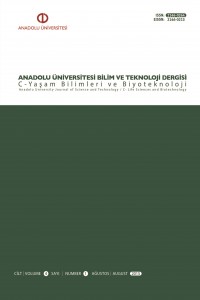Öz
Stachys cinsi (Lamiaceae) dünya üzerinde tanımlanmış yaklaşık 300 türle geniş bir yayılış gösterirken, bu cins ülkemizde %48 endemizm oranıyla 91 tür ve 116 taksa ile temsil edilmektedir. Anadolu’da “Deli adaçayı” veya “Dağ çayı” isimleriyle bilinen Stachys türleri sahip olduğu antibakteriyel, antienflamatuvar, antipiretik, antioksidan ve sitotoksik etkilerinden dolayı, halk arasında cilt hastalıkları, ülser, kanser, solunum rahatsızlıkları ve böbrek hastalıklarında kullanılmaktadır. Yapılan çalışmalarda sekonder metabolitlerinin genellikle iridoit ve flavon glikozitleri ile diterpenler ve uçucu yağlar olduğu ortaya konmuştur.
Çalışmamızda Mersin ve civarı için endemik olan Stachys rupestris Montbret et Aucher ex Benth.’in çiçekli toprak üstü kısımlarından hidrodistilasyon ile elde edilen uçucu yağın kompozisyonu gaz kromatografisi/alev iyonlaşma dedektörü ve gaz kromatografisi/kütle spektrometresi ile ortaya konmuştur, Ana bileşenler a-pinen (%14.4), tetradekanoik asit (%10.3) ve β-karyofillen (%5.3) olarak saptanmıştır.
Uçucu yağın patojen bakteri ve maya türlerine karşı antimikrobiyal özellikleri “Klinik ve Laboratuvar Standartları Enstitüsü”nün yayımladığı CLSI M27-A2 ve M7-A7 protokolleri uyarınca mikrodilüsyon duyarlılık testleri ile ortaya konmuştur. Yağın bakterilere kıyasla test edilen Candida türlerine karşı daha etkili olduğu görülmüş, Candida parapsilosis, C. zeylanoides ve C. krusei’yi 31,25 µg/mL, C. zeylanoides’i ise 15,0 µg/mL konsantrasyonda (MİK) inhibe ettiği belirlenmiştir.
Anahtar Kelimeler
Lamiaceae Stachys Uçucu yağ Gaz kromatografisi Antimikrobiyal MİK
Kaynakça
- Adams, R.P. (2001). Identification of Essential Oil Components by Gas Chromatography/Quadrupole Mass Spectroscopy, Allured Publishing, 362 South Schmale Road, Carol Stream, IL 60188-2787, USA. Avrupa Farmakopesi Adaptasyonu, Türk Farmakopesi-1 (2004), Distilasyonla Su Tayini, T.C. Sağlık Bakanlığı, İlaç ve Eczacılık Genel Müdürlüğü Yayını, 29-30. Bassole, I.H.N., Juliani, H.R. (2012). Essential Oils in Combination and their Antimicrobial Properties, Molecules, 17, 3989-4006. Baştürk, K, Dinç, M., Doğu, S. (2015). Anatomical characteristics of Turkish endemic Stachys rupestris Montbret et Aucher ex Bentham (Lamiaceae). Modern Phytomorphology, 8, 37–40. Baytop, T. (1999). Türkiye’de Bitkiler ile Tedavi Geçmişten Bugüne (Therapy with Medicinal Plants in Turkey-Past and Present). 2nd Ed, Nobel Tıp Basımevi, Istanbul, Turkey. Cellat, K., Gül, Ş., Everest, A. (2011). Mersin’deki Stachys rupestris Montbret et Aucher ex Bentham Türünün Eterik Yağ İçeriğinin Araştırılması. Lokman Hekim Journal, 7. Lokman Hekim Günleri. Poster Bildiri, 11-14 Mayıs 2011. CLSI (NCCLS) M27-A2. (2002). Reference Method for Broth Dilution Antifungal Susceptibility Testing of Yeasts; Approved Standard, Second Edition. CLSI (NCCLS) M7-A7. (2006). Methods for Dilution Antimicrobial Susceptibility Tests for Bacteria That Grow Aerobically; Approved Standard, Seventh Edition. Davis P.H., Edmondson J.R., Mill R.R., Tan K. (1988). Flora of Turkey and East Aegean Islands. Vol. 7. Edinburg: Edinburg University Press. Dündar, E., Akçiçek, E., Dirmenci, T., Akgün, Ş. (2013). Phylogenetic Analysis of the Genus Stachys Sect. Eriostomum (Lamiaceae) in Turkey based on Nuclear Ribosomal ITS Sequences. Turk J Bot, 37, 14-23. Erdogan, E. A., Everest, A., De Martino, L., Mancini, E., Festa, M., De Feo, V. (2013). Chemical Composition and In vitro Cytotoxic Activity of the Essential Oils of Stachys rupestris and Salvia heldreichiana, Two Endemic Plants of Turkey, Natural Product Communications 8 (11), 1637-1640. Koenig, W.A. Joulain, D. Hochmuth, D.H. (2004). Terpenoids and Related Constituents of Essential Oils. MassFinder 3, Hamburg, Germany. McLafferty, F.W. Stauffer, D.B. (1989).The Wiley/NBS Registry of Mass Spectral Data, J. Wiley and Sons, New York. Moran, G.P. Sullivan, D.J. Henman, M.C. McCreary, C.E. Harrington, B.J. Shanley, D.B. Coleman, D.C. (1997). Antifungal Drug Susceptibilities of oral Candida dubliniensis Isolates from Human Immunodeficiency Virus (HIV)-Infected and Non-Hiv-Infected Subjects and Generation of Stable FluconazoleResistant Derivatives in vitro. Antimicrob. Agents Ch., 41, 617. Piozzi, F., Bruno, M. (2011). Diterpenoids from Roots and Aerial Parts of the Genus Stachys, Rec. Nat. Prod., 5(1), 1-11. Radulovic, N., Lazarevic, J., Ristic, N., Palic, R. (2007). Chemotaxonomic significance of the volatiles in the genus Stachys (Lamiaceae): Essential oil Composition of Four Balkan Stachys Species. Biochemical Systematics and Ecology 35, 196-208. Şerbetçi, T., Demirci, B., Güzel, Ç.B., Kültür, Ş., Ergüven, M., Başer, K.H.C. (2010). Essential Oil Composition, Antimicrobial and Cytotoxic Activities of Two Endemic Stachys cretica Subspecies (Lamiaceae) from Turkey, Natural Product Communications, 5(9), 1369-1374.
- Tundis, R., Peruzzi, L., Menichini, F. (2014). Phytochemical and Biological Studies of Stachys Species in Relation to Chemotaxonomy: A Review. Phytochemistry 102, 7-39. Ugur, A., Sarac, N., Varol, O. (2013). Antimicrobial Activities of the Essential Oils of Endemic Stachys rupestris and Stachys amanica Against Multi-Resistant Bacteria, Indian Journal of Pharmacology 45(2), 201-202.
Ayrıntılar
| Birincil Dil | Türkçe |
|---|---|
| Bölüm | Araştırma Makalesi |
| Yazarlar | |
| Yayımlanma Tarihi | 12 Ocak 2016 |
| Yayımlandığı Sayı | Yıl 2015 Cilt: 4 Sayı: 1 |


